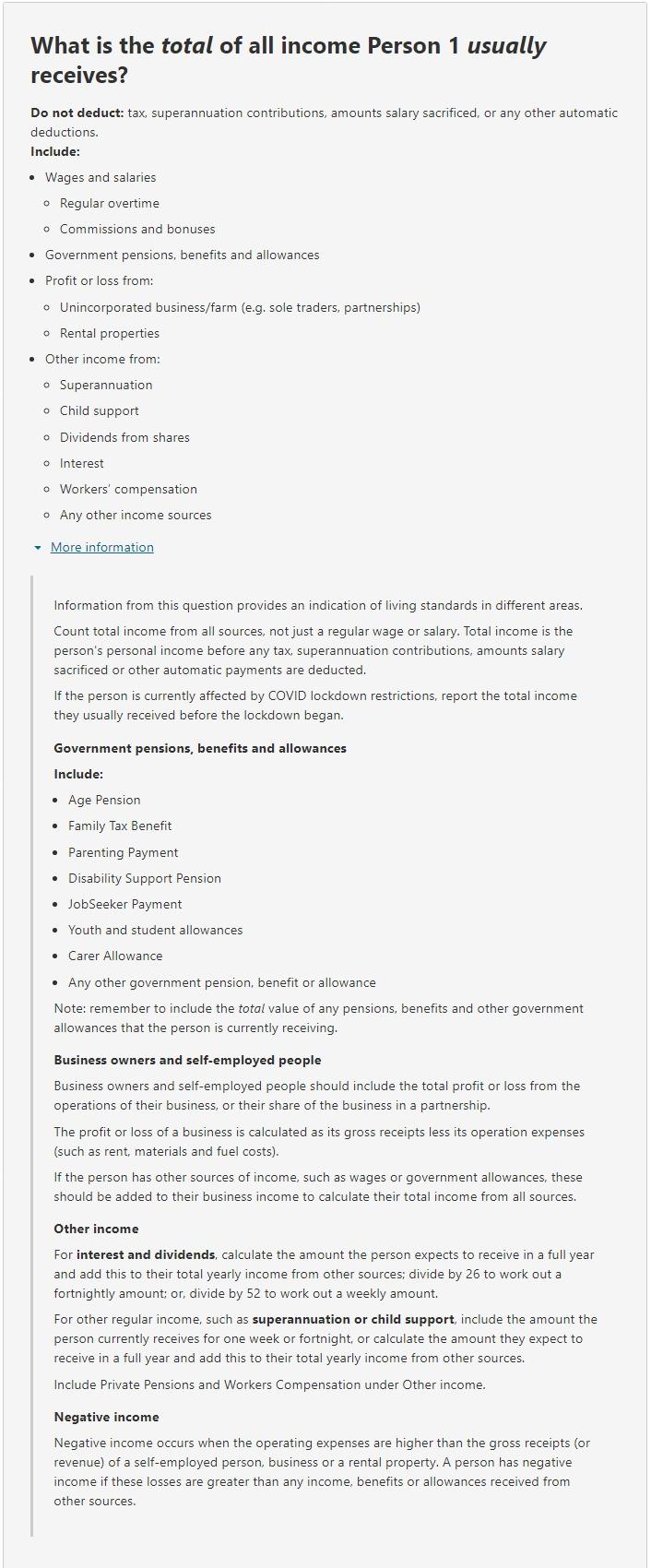Total family income as stated (weekly) (FINASF)
Definition
This variable records the total family income by summing the Total personal income (weekly) (INCP) of each family member aged 15 years and over present in the household on Census Night.
This includes families where one or more family member's income details were not stated or they were away from the dwelling on Census Night.
Scope
Families in family households
Categories
Annual income ranges are displayed within brackets.
| Code | Category |
|---|---|
| 01 | Negative income |
| 02 | Nil income |
| 03 | $1-$149 ($1-$7,799) |
| 04 | $150-$299 ($7,800-$15,599) |
| 05 | $300-$399 ($15,600-$20,799) |
| 06 | $400-$499 ($20,800-$25,999) |
| 07 | $500-$649 ($26,000-$33,799) |
| 08 | $650-$799 ($33,800-$41,599) |
| 09 | $800-$999 ($41,600-$51,999) |
| 10 | $1,000-$1,249 ($52,000-$64,999) |
| 11 | $1,250-$1,499 ($65,000-$77,999) |
| 12 | $1,500-$1,749 ($78,000-$90,999) |
| 13 | $1,750-$1,999 ($91,000-$103,999) |
| 14 | $2,000-$2,499 ($104,000-$129,999) |
| 15 | $2,500-$2,999 ($130,000-$155,999) |
| 16 | $3,000-$3,499 ($156,000-$181,999) |
| 17 | $3,500-$3,999 ($182,000-$207,999) |
| 18 | $4,000-$4,499 ($208,000-$233,999) |
| 19 | $4,500-$4,999 ($234,000-$259,999) |
| 20 | $5,000-$5,999 ($260,000-$311,999) |
| 21 | $6,000-$7,999 ($312,000-$415,999) |
| 22 | $8,000 or more ($416,000 or more) |
| && | All incomes not stated |
| @@ | Not applicable |
Number of categories: 24
Not applicable (@@) category comprises:
- Non-family/Non-classifiable households
- Unoccupied private dwellings
- Non-private dwellings
- Migratory, off-shore and shipping SA1s
Question(s) from the Census form
What is the person’s relationship to Person1/Person 2?
What is the total of all income the person usually receives?
For each person away, complete the following questions:
How this variable is created
Data for this variable is collected from the Relationship in household and Income questions on the Census form. Data can also be collected from the questions asked of people who were away from the household on Census Night.
Total family income as stated (weekly) (FINASF) is calculated by summing the personal incomes reported by all family members aged 15 years and over present in the household on Census Night who state their income. The Census collects personal income in ranges, so before these can be summed, a specific dollar amount needs to be allocated to each person. Median incomes for each range, derived using data from the Survey of Income and Housing are used for this purpose.
Where no family member aged 15 years and over has stated their income, the household is classified as 'All incomes not stated'.
History and changes
This variable was first introduced in 2006. For the 2016 Census, categories for family income in dollar ranges were revised.
No changes have been made to the family income categories for 2021.
Data use considerations
Usual residents may not be included in the household’s Census form because they were away from the dwelling on Census Night. In this case they should be included in the section of the form for people who were away on Census Night. This can occur in both family and group households. Due to form limitations a maximum of three people can be reported and coded as temporarily absent from the dwelling. If more than three people are absent from the household the additional people are unable to be included on the form.
Total family income as stated (weekly) (FINASF) can be used in conjunction with Total personal income (weekly) (INCP) to create a new family income variable.
Total family income as stated (weekly) (FINASF) should be used with caution when comparing to other family data from within the ABS and for external organisations or agencies. The definition of a family can differ between different statistical collections and may not match Census definitions.
Increases to counts in the higher family income ranges can be partly attributed to the addition of a higher income range to the personal income question. For more details, see Total personal income (weekly) (INCP).
Total family income as stated (weekly) (FINASF) does not have a non-response rate is it created during Census processing using responses from the Relationship in household, Income and persons temporarily absent questions on the Census form.

